Information Center
A surface is said to be wetted if a liquid spreads over the surface evenly without the formation of droplets. When the liquid is water and it spreads over the surface without the formation of droplets, the surface is said to be hydrophilic. In terms of energetics, this implies that the forces associated with the interaction of water with the surface are greater than the cohesive forces associated with bulk liquid water. Water droplets form on hydrophobic surfaces, implying that the cohesive forces associated with bulk water are greater than the forces associated with the interaction of water with the surface.
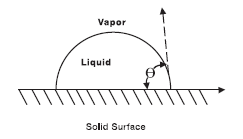
Contact Angle Defines Wettability
Practically, hydrophobicity and hydrophilicity are relative terms. A simple quantitative method for defining the relative degree of interaction of a liquid with a solid surface is the contact angle of a liquid droplet on a solid substrate. If the contact angle of water is less than 30°, the surface is designated hydrophilic since the forces of interaction between water and the surface nearly equal the cohesive forces of bulk water and water does not cleanly drain from the surface. If water spreads over a surface and the contact angle at the spreading front edge of the water is less than 10°, the surface is often designated as superhydrophilic (provided that the surface is not absorbing the water, dissolving in the water or reacting with the water). On a hydrophobic surface, water forms distinct droplets. As the hydrophobicity increases, the contact angle of the droplets with the surface increases. Surfaces with contact angles greater than 90° are designated as hydrophobic. The theoretical maximum contact angle for water on a smooth surface is 120°. Micro-textured or micro-patterned surfaces with hydrophobic asperities can exhibit apparent contact angles exceeding 150° and are associated with superhydrophobicity and the “lotus effect”.
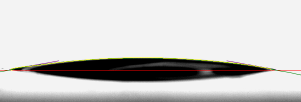 |
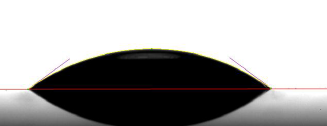 |
| Hydrophilic surface ”good wetting” | Ordinary Surface-“typical wetting” |
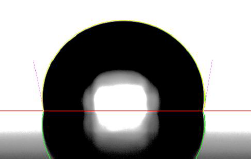 |
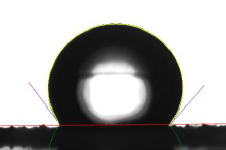 |
| Hydrophobic surface “poor wetting” | super-hydrophobic surface |
The following chart outlines the relative level of hydrophobicity and hydrophilicity.
- Super-hydrophobic 150° and greater
- Hydrophobic 90° to 120°
- Normal 30° to 90°*
- Hydrophilic below 20°
- Super-hydrophilic below 10°
Contact Angle of Water on Smooth Surfaces
|
No. |
Name |
Contact angle θ |
|
1 |
heptadecafluorodecyltrimethoxysilane* |
115° |
|
2 |
(heptafluoroisopropoxy) propyltrichlorosilane* |
109-111° |
|
3 |
poly(tetrafluoroethylene) |
108-112° |
|
4 |
poly(propylene) |
108° |
|
5 |
octadecyldimethylchlorosilane* |
110° |
|
6 |
octadecyltrichlorosilane* |
102-109° |
|
7 |
tris(trimethylsiloxy)- silylethyldimethylchlorosilane |
104° |
|
8 |
octyldimethylchlorosilane* |
104° |
|
9 |
dimethyldichlorosilane* |
95-105° |
|
10 |
butyldimethylchlorosilane* |
100° |
|
11 |
trimethylchlorosilane* |
90-100° |
|
12 |
poly(ethylene) |
88-103° |
|
13 |
poly(styrene) |
94° |
|
14 |
poly(chlorotrifluoroethylene) |
90° |
|
15 |
human skin |
75-90° |
|
16 |
diamond |
87° |
|
17 |
graphite |
86° |
|
18 |
silicon (etched) |
86-88° |
|
19 |
talc |
50-55° |
|
20 |
chitosan |
80-81° |
|
21 |
steel |
70-75° |
|
22 |
methacryloxypropyltrimethoxysilane |
70° |
|
23 |
gold, typical (see gold, clean) |
66° |
|
24 |
triethoxysilylpropoxy(triethylenoxy)- dodecanoate* |
61-2° |
|
25 |
intestinal mucosa |
50-60° |
|
26 |
glycidoxypropyltrimethoxysilane* |
49° |
|
27 |
kaolin |
42-46° |
|
28 |
platinum |
40° |
|
29 |
silicon nitride |
28-30° |
|
30 |
silver iodide |
17° |
|
31 |
methoxy(polyethyleneoxy)propyltrimethoxysilane* |
15.5° |
|
32 |
soda-lime glass |
<15° |
|
33 |
gold, clean |
<10° |
Hot keywords of USA KINO:contact angle, contact angle measurement, contact angle meter, contact angle goniometer, surface tensiometer, interfacial tensiometer, surface tension measurement, surface tension, surface tensiometry, contact angle measurement equipment and device, calculating surfac free energy, Determining Critical Micelle Concentration (CMC) of surfactant, made in China Method for choosing surface tensiometer NEW Method for choosing contact angle meter (goniometer) NEW Method for choosing interfacial tension meter NEW

Manage technical support: www.chem17.com GoogleSitemap
MainPro : contact angle,contact angle meter,contact angle goniometer,surface tension,surface tensiometer